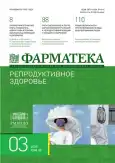Комплексная биологически активная добавка пробиотического действия в терапии нарушений влагалищного биотопа у женщин периода перименопаузального перехода (обсервационное наблюдательное исследование «случай–контроль»)
- Авторы: Енькова Е.В.1, Обернихин К.И.1, Енькова В.В.1, Сметанкина А.В.1
-
Учреждения:
- Воронежский государственный медицинский университет им. Н.Н. Бурденко
- Выпуск: Том 32, № 3 (2025)
- Страницы: 134-140
- Раздел: Оригинальные статьи
- Статья опубликована: 13.08.2025
- URL: https://journals.eco-vector.com/2073-4034/article/view/688980
- DOI: https://doi.org/10.18565/pharmateca.2025.3.134-140
- ID: 688980
Цитировать
Полный текст
Аннотация
Обоснование: Дисбиотические нарушения влагалищной микрофлоры на сегодняшний день остаются одной из актуальных проблем в акушерстве и гинекологии. По данным Министерства здравоохранения Российской Федерации, на долю данного состояния приходится порядка 40% случаев всей гинекологической патологии в общей популяции. Бактериальный вагиноз (БВ) в случае несвоевременных диагностики и лечения представляет собой угрозу развития воспалительных заболеваний органов малого таза, преждевременных родов, генитоуринарного менопаузального синдрома.
Цель исследования: провести клиническую оценку эффективности включения комплексной биологически активной добавки пробиотического действия в схему коррекции нарушений влагалищного биотопа у женщин в период перименопаузы.
Материалы и методы: Обсервационное наблюдательное исследование «случай-контроль» выполнено на базе кафедры акушерства и гинекологии №2 Воронежского государственного медицинского университета им. Н.Н. Бурденко в период с 2024 по 2025 г. В исследовании приняло участие 50 женщин периода перименопаузального перехода (STRAW+10). Из них сформировано 3 группы сравнения: 1 группа (n=20) – пациентки перименопаузального периода, получающие классическую схему коррекции дисбиотических нарушений (метронидазол 500 мг + хлорамфеникол 200 мг + натамицин 150 мг + гидрокортизона ацетат 15 мг в течение 10 дней, затем – Максилак© в течение 10 дней); 2 группа (n=20) – пациентки перименопаузального периода, получающие комбинированную экспериментальную схему коррекции дисбиотических нарушений (метронидазол 500 мг + хлорамфеникол 200 мг + натамицин 150 мг + гидрокортизона ацетат в течение 10 дней, затем – препарат лактобацилл в течение 10 дней); 3 группа – контроль (n=10) – пациентки перименопаузального периода без нарушений влагалищного биотопа. Женщинам, включенным в эксперимент, проведен полный спектр лабораторных и инструментальных исследований в соответствии с клиническими рекомендациями МЗ РФ «Бактериальный вагиноз» и «Менопауза и климактерическое состояние у женщины». Статистическая обработка проведена в Statistica 10.0 (StatSoft), различия считали статистически значимыми при р<0,05.
Результаты: Для пациенток 2 группы, получающих классическую схему терапии БВ, в сравнении с группой получающих экспериментальную схему (прием синбиотика Максилак©), характерна относительно низкая скорость элиминации возбудителя, а также низкая скорость заселения влагалищного биотопа ацидофильными лактобактериями. В группе экспериментальной схемы терапии БВ установлена ранняя элиминация патогенной и условно-патогенной микрофлоры, раннее заселение нормофлорой.
Заключение: Включение в схему лечения БВ у женщин в перименопаузе синбиотика Максилак© позволяет улучшать клинические эффекты терапии за счет относительно быстрой элиминации условно-патогенных и патогенных возбудителей, а также за счет раннего восстановления влагалищного биоценоза.
Ключевые слова
Полный текст
Об авторах
Елена Владимировна Енькова
Воронежский государственный медицинский университет им. Н.Н. Бурденко
Автор, ответственный за переписку.
Email: enkova@bk.ru
ORCID iD: 0000-0001-8885-1587
заслуженный врач Российской Федерации, д.м.н., профессор, зав. кафедрой акушерства и гинекологии № 2
Россия, ВоронежКирилл Игоревич Обернихин
Воронежский государственный медицинский университет им. Н.Н. Бурденко
Email: enkova@bk.ru
ORCID iD: 0000-0001-7385-6211
ассистент кафедры оперативной хирургии с топографической анатомией
Россия, ВоронежВалерия Вадимовна Енькова
Воронежский государственный медицинский университет им. Н.Н. Бурденко
Email: enkova@bk.ru
ORCID iD: 0000-0002-3383-5755
к.м.н., доцент кафедры акушерства и гинекологии № 2
Россия, ВоронежАнастасия Васильевна Сметанкина
Воронежский государственный медицинский университет им. Н.Н. Бурденко
Email: enkova@bk.ru
ORCID iD: 0009-0005-9146-4779
врач-акушер-гинеколог, соискатель кафедры акушерства и гинекологии № 2
Россия, ВоронежСписок литературы
- Garcia-Velasco J.A., Budding D., Campe H., et al. The reproductive microbiome – Clinical practice recommendations for fertility specialists. Reprod Biomed Online. 2020;41:443–453. https://dx.doi.org/10.1016/j.rbmo.2020.06.014
- Aragon I.M., Herrera-Imbroda B., Queipo-Ortuno M.I., et al. The Urinary Tract Microbiome in Health and Disease. Eur Urol Focus. 2020;4:128–138. https://dx.doi.org/10.1016/j.euf.2016.11.001
- The Integrative HMP (iHMP) Research Network Consortium. The Integrative Human Microbiome Project. Nature. 2020;569:641–648. https://dx.doi.org/10.1038/s41586-019-1238-8
- Moreno I., Simon C. Deciphering the effect of reproductive tract microbiota on human reproduction. Reprod Med Biol. 2019;18:40–50. https://dx.doi.org/10.1002/rmb2.12249
- Vitale S.G., Loen L.K., Tjiat N.T. The Role of Genital Tract Microbiome in Fertility: A Systematic Review. Int J Mol Sci. 2021;23:180. https://dx.doi.org/10.3390/ijms23010180
- Wolf E.A., Rettig H.C., Lupatsii M., et al. Culturomics Approaches Expand the Diagnostic Accuracy for Sexually Transmitted Infections. Int J Mol Sci. 2021;22:10815. https://dx.doi.org/10.3390/ijms221910815
- Kumar J., Kumar M., Gupta S., et al. An Improved Methodology to Overcome Key Issues in Human Fecal Metagenomic DNA Extraction. Genomics Proteomics Bioinformatics. 2020;14:371–378. doi: 10.1016/j.gpb.2016.06.002.
- Dominguez-Bello M.G., Costello E.K., Contreras M., et al. Delivery mode shapes the acquisition and structure of the initial microbiota across multiple body habitats in newborns. Proc Natl Acad Sci U S A. 2019;107:11971–11975. https://dx.doi.org/10.1073/pnas.1002601107
- O’Hanlon D.E., Come R.A., Moench T.R. Vaginal pH measured in vivo: Lactobacilli determine pH and lactic acid concentration. BMC Microbiol. 2020;19:13. https://dx.doi.org/10.1186/s12866-019-1388-8
- Brotman R.M., Bai G., Sakamoto J., et al. Temporal dynamics of the vaginal microbiota. Sci Transl Med. 2021;4:132ra52. https://dx.doi.org/10.1126/scitranslmed.3003605
- Zheng J., Wittouck S., Salvetti E., et al. A taxonomic note on the genus Lactobacillus: Description of 23 novel genera, emended description of the genus Lactobacillus Beijerinck 1901, and union of Lactobacillaceae and Leuconostocaceae. Int J Syst Evol Microbiol. 2020;70:2782–2858. https://dx.doi.org/10.1099/ijsem.0.004107
- Lehtoranta L., Ala-Jaakkola R., Laitila A., et al. Healthy Vaginal Microbiota and Influence of Probiotics Across the Female Life Span. Front Microbiol. 2022;13:819958. https://dx.doi.org/10.3389/fmicb.2022.819958
- Stennett C.A., Dyer T.V., He X., et al. A cross-sectional pilot study of birth mode and vaginal microbiota in reproductive-age women. PLoS ONE. 2020;15:e0228574. https://dx.doi.org/10.1371/journal.pone.0228574
- Keag O.E., Norman J.E., Stock S.J. Long-term risks and benefits associated with cesarean delivery for mother, baby, and subsequent pregnancies: Systematic review and meta-analysis. PLoS Medicine. 2019;15:e1002494. https://dx.doi.org/10.1371/journal.pmed.1002498
- Brusselaers N., Shrestha S., van de Wijgert J., et al. Vaginal dysbiosis and the risk of human papillomavirus and cervical cancer: Systematic review and meta-analysis. Am J Obstet Gynecol. 2020;221:9–18.e8. https://dx.doi.org/10.1016/j.ajog.2018.12.011
Дополнительные файлы





